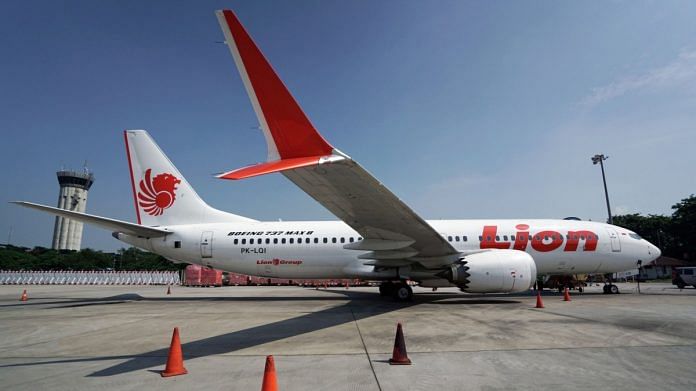Just three years after the crash of Lion Air Flight 610 shortly after takeoff from Jakarta precipitated a chain of events leading to the worldwide grounding of Boeing’s flagship 737 Max 8 plane, a strange thing is happening.
The single-aisle jet — whose crashes in Indonesia and, less than five months later, outside Ethiopia’s capital, Addis Ababa, “exposed fraudulent and deceptive” behavior and criminal misconduct by Boeing employees, in the words of the U.S. Department of Justice — is looking more and more like becoming a commercial success story.
Mumbai-based startup Akasa Air announced an order Tuesday for 72 of the jets at the Dubai Airshow, a deal worth $9 billion at list prices. Indian budget carrier SpiceJet Ltd. said Wednesday it had settled claims with Boeing and could resume taking deliveries from its 155-strong order. FlyDubai, at one point the Max’s biggest customer before canceling 65 in the wake of the crashes, is still considering the aircraft for future orders, Chief Executive Officer Ghaith Al-Ghaith said this week.
Singapore Airlines Ltd. will soon start flying the Max to destinations including Indonesia. China, where about a third of the 370 completed planes are destined for delivery, may be preparing to clear it to fly again.
Boeing’s conduct through the development of the 737 Max was unconscionable, as Peter Robison’s deep reporting in the current issue of Bloomberg Businessweek illustrates. The five months of stalling and obfuscation that followed the deaths of 189 passengers and crew in the Lion Air crash was still more shameful, endangering tens of thousands of people until the deaths of another 157 on Ethiopian Airlines Flight 302 finally forced a worldwide grounding of the model.
At the same time, investors are well-known for their brutal lack of sentiment. The only question they care about right now is: Will it make money?
On that front, the news is oddly promising. Boeing’s year-to-date orders for single-aisle jets at the end of October were running at about double the level notched up by Airbus SE — an important consideration when profitability is all about efficiencies of scale. If that lead is maintained, it will be the first time since 2016 that the U.S. manufacturer has run ahead of its arch-rival in this most important segment of the market.
With aviation returning to something like normal over the coming 12 months (especially on the domestic routes where smaller jets like the 737 dominate), the bigger risk to Boeing right now is not that they don’t have customers for the Max, but that they won’t be able to deliver them fast enough once the current inventory is dispatched.
The 737 program will “shift from what used to be a demand problem to more of a supply problem in the course of the next calendar year,” Chief Executive Officer David Calhoun told an investor call Oct. 27. “All of the trends are in our favor on that front.” New customers can’t expect to see the sorts of discounts on sale prices that the airlines affected by the Max’s worldwide grounding have received, he added.
Compared to the 787 Dreamliner so beloved of air passengers and the hotly-anticipated 777X, the 737 is a bright spot for Boeing. Under the program accounting rules it uses to amortize multibillion-dollar development costs over the lifetime of an aircraft model, the 787 was $1.8 billion short of breaking even at the end of September. A $6.5 billion writedown of the 777X program after the Covid-19 pandemic and other problems delayed its delivery by three years means that twin-aisle jet will also struggle to get back into the black.
The 737, however, is still forecast to stay just on the right side of profitability — and with thousands of deliveries to make up those costs compared to just hundreds for the bigger planes, there’s ample opportunity to keep and exceed that promise.
The harsh truth of the aviation market is that carriers fear an Airbus untrammeled by commercial competition far more than they fear for the safety of the 737 Max — especially after it’s gone through years of checks under the eye of a newly-empowered regulator. Given the ongoing delays, certification and supply-chain problems faced by the only other serious competitor on the horizon, Commercial Aircraft Corp. of China’s C919, the risks of Airbus dominance are greater still.
The cost-cutting considerations that contributed to the Max’s failures also loom large. The stereotype among pilots is that Airbus planes are largely automated to make life easy for less experienced aviators, while Boeing left the crew more in control until making a move toward the PlayStation ergonomics of Airbus with the 737 Max. If the model is indeed simpler to master even if, post-grounding, the training requirements are now more rigorous, that’s an important consideration in an industry heading toward a projected shortage of about 34,000 pilots globally by 2025.
Travelers will no doubt swear that they’ll never get on a 737 Max, given its appalling history. However, faced with a choice of flying or waiting for another slot at the departure gate, passengers who grumble yet still cram themselves into 28-inch seats will end up piling into whatever plane airlines choose to provide. Right now, they like the look of the Max. The rest of us best get used to it. –Bloomberg
Also read: Rakesh Jhunjhunwala’s low-cost Akasa airline could launch operations with Boeing 737 Max fleet



